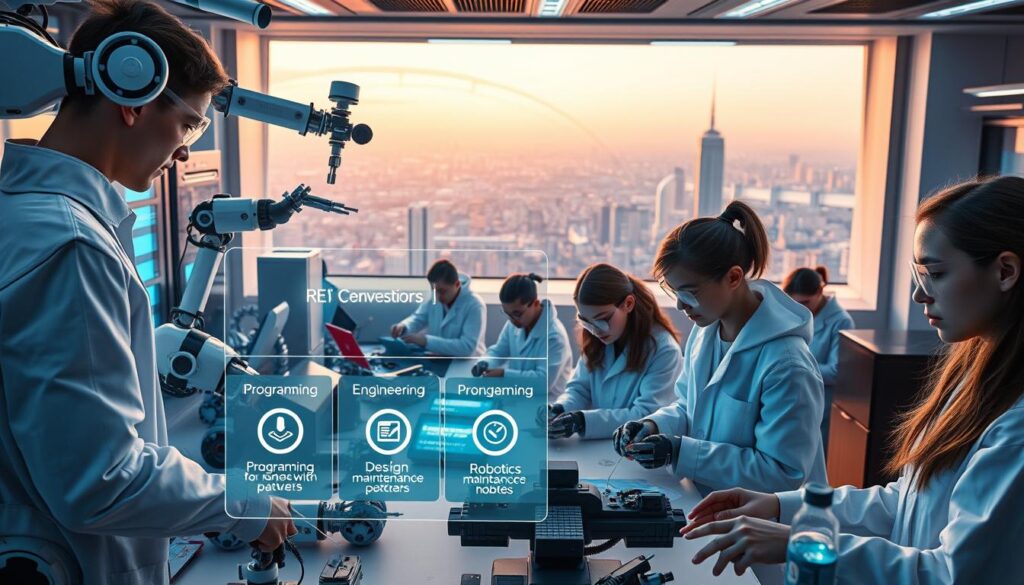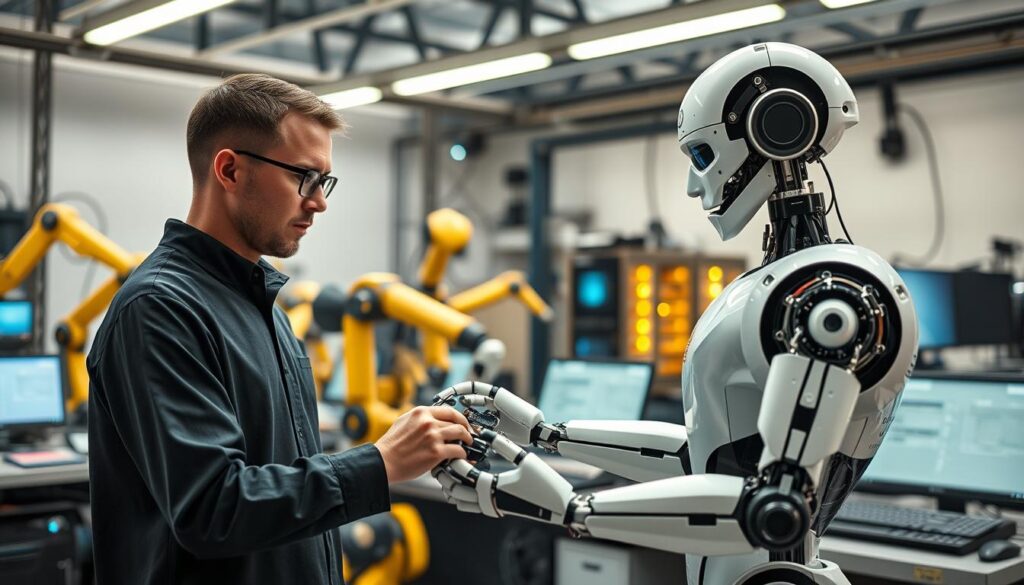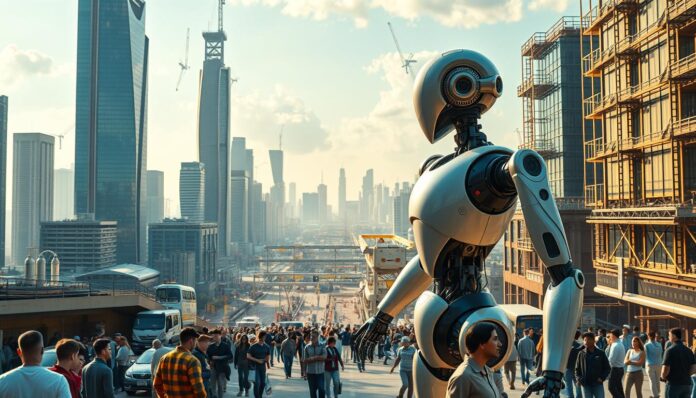Could AI robotics soon outperform human capabilities in complex decision-making tasks? As ai robotics advances, this question pushes us to rethink boundaries between technology and human expertise. This article reveals how the fusion of artificial intelligence robotics is reshaping industries, from manufacturing to healthcare.
Imagine a world where robots learn, adapt, and execute tasks smarter than ever before. This guide explains how businesses can harness these innovations to drive growth and efficiency. Discover real-world examples and actionable strategies to integrate ai robotics into your operations.
Key Takeaways
- AI robotics combines machine learning with physical automation to solve modern challenges.
- Industries like healthcare and manufacturing are already adopting these technologies at scale.
- Companies using ai robotics report up to 40% efficiency improvements in critical processes.
- Ethical and technical hurdles still require careful navigation for successful implementation.
- Emerging trends point to even greater integration in daily business and consumer settings.
Understanding AI Robotics
AI robotics is all about combining artificial intelligence with mechanical engineering. This mix creates smart systems that are changing industries. Let’s dive into what this technology is and why it’s important.
Defining AI Robotics
AI robotics uses artificial intelligence and mechanical engineering together. These systems have sensors, algorithms, and data to understand their environment. They can make decisions on their own, without needing a human all the time.
Think of a factory robot that can change its tasks as needed. This is what robotics technology makes possible.
“The fusion of AI and robotics isn’t just tech—it’s the future of problem-solving.”
Importance in Modern Technology
- Manufacturing uses robotics and ai to make things faster and more precise.
- Healthcare uses AI robotics for surgeries and patient care.
- Robotics technology is key to Industry 4.0, making factories smarter.
Companies are spending a lot because these systems save money, improve safety, and do tasks humans can’t. From making things on assembly lines to helping in hospitals, this technology is now a part of our everyday lives.
Key Components of AI Robotics
Every advanced robot has three main parts working together. These parts help robots understand and act on their surroundings. Let’s look at each key element that makes this technology so advanced.
Artificial Intelligence
Artificial intelligence is at the heart of decision-making in robots. Machine learning lets robots see patterns, guess what will happen next, and change their plans. Companies like NVIDIA use AI to make drones that can change their flight paths on their own.
This thinking part is the core of artificial intelligence robotics. It turns data into actions.
Robotics Engineering
- Mechanical frameworks determine a robot’s physical capabilities.
- Electrical systems ensure precise power distribution and control.
- Material science advances allow lighter, stronger frames.
Companies like Boston Dynamics mix these parts to create amazing robots. For example, the Atlas robot can stand on one leg or jump over things.
Sensors and Actuators
Sensors are like the robot’s senses. They use lidar, cameras, and pressure gauges to gather information. Actuators then turn this data into movement, like a robotic arm welding in a car factory.
Bosch Sensortec’s new sensors can even detect vibrations to stop mechanical problems before they start.
These parts together make up the blueprint of modern robotics. As robotics gets better, each part, from code to circuits, helps create the next smart machines.
Applications of AI Robotics
AI robotics is changing the world. It’s used in factories, hospitals, farms, and homes. These technologies solve real problems. Let’s see how they make things better.
Manufacturing and Automation
Robotics is changing assembly lines. Tesla uses AI robots to make cars faster. Fanuc’s robots check parts for quality. These robots work all day, every day, saving money and improving work.
Healthcare Solutions
Surgeons use the da Vinci System for precise surgeries. Ekso Bionics’ robots help patients move again. ai robotics applications also help find new medicines faster.
Agricultural Innovations
Blue River Technology’s See & Spray robots find weeds to save herbicides. John Deere’s robots help with planting and harvesting. They solve labor problems and increase crop yields.
Consumer Products
iRobot’s Roomba cleans on its own. Anki’s Cozmo teaches kids to code. These robots make our lives easier by doing simple tasks for us.
| Industry | Application | Example | Impact |
|---|---|---|---|
| Manufacturing | Quality control | Fanuc robots | Error reduction |
| Healthcare | Surgical assistance | da Vinci System | Precise operations |
| Agriculture | Weed detection | Blue River | Resource efficiency |
| Consumer | Home automation | iRobot Roomba | Time-saving |
These examples show how AI robotics solves problems. By using these tools, businesses can innovate and stay ahead.
Benefits of AI Robotics
Using ai robotics brings big wins for businesses. These systems do tasks quicker, more accurately, and cheaper than old ways. Let’s see how they change your work.
Increased Efficiency comes from ai robotics doing repetitive jobs non-stop. A 2023 study found factories using them see a 35% boost in production. They also make supply chains better, cutting downtime by 20-30%.
- Enhanced Precision: Robotics innovation gets things right down to the micron in surgeries and electronics. This cuts human mistakes by over 90%. It makes products better and customers happier.
- Cost Reduction: Companies spend 25-30% less on operations with ai robotics. For example, automated warehouses save on storage by using ai robotics smartly.
Studies show manufacturers save $1.2 million a year per facility with ai robotics. The payback usually comes in 18-24 months. These technologies fit right into today’s business goals.
Robotics innovation is more than saving money. It’s about creating systems that last and grow with your needs. See how ai robotics can change what’s possible for your work.
Challenges in AI Robotics
Using artificial intelligence robotics comes with big hurdles. These include ethical, technical, and operational issues. These problems affect how well and how long these systems work.
Ethical Considerations
Privacy and bias in AI are major concerns. For instance:
- Data collection can invade personal privacy
- Algorithms might show bias in hiring or policing
- Decisions made by robots need clear rules
“Ethical AI development must be a core part of robotics technology design,” states Dr. Elena Torres, MIT Robotics Ethics Lab.
Technical Limitations
Today’s robotics technology has physical and mental limits:
- Robots need a lot of energy, making them hard to use in remote places
- They struggle in places without clear paths
- Robots can’t do things as well as humans
Integration Issues
Adding artificial intelligence robotics to old systems is tough:
- Old machines and new tech don’t always work together
- Workers need training to use new robots
- Rules about using AI vary by place
| Challenge | Solution |
|---|---|
| Algorithmic bias | Third-party audits and diverse training data |
| Power constraints | Solar-powered designs and energy-efficient chips |
| Legacy system conflicts | API middleware and phased rollouts |
The Future of AI Robotics
Technology is moving fast, and the next big thing in robotics innovation will change many areas of life. Here’s what’s coming:
Trends to Watch
New trends will lead to big leaps in machine learning robotics and more. Keep an eye on these areas:
- 5G and Edge Computing: This tech will make robots make decisions faster.
- Augmented Reality (AR) Integration: AR will make working with robots easier in places like factories and stores.
Expected Innovations
Look out for big changes like soft robotics and neuromorphic computing. Here are some upcoming ideas:
- Swarm robotics for teams that work together in emergencies.
- Robots that can fix themselves, making them last longer.
- AI that predicts when machines need repairs, cutting down on downtime.
AI Robotics in Everyday Life
Get ready for robots to become a part of your daily life. Imagine:
- Health monitors that learn your habits with machine learning robotics.
- Cities that run smarter, saving energy and improving traffic flow.
- Robotic teachers that adjust lessons on the fly.
To stay ahead, think about how robotics innovation might change your field. Those who start early will have an edge as these technologies grow.
Industry Leaders in AI Robotics
Exploring robotics development and robotics and ai shows us key players. Top companies are changing automation, offering new solutions globally. They share insights on trends and chances.
Major Companies to Follow
- Boston Dynamics: Creates dynamic robots like Atlas, known for its smart moves and AI.
- ABB Robotics: Excels in industrial automation, making robots for better factory work.
- FANUC: A top name in robotic manufacturing, improving assembly lines with robotics and ai.
Startups Making an Impact
New innovators solve specific problems with fresh ideas:
- Covariant: Powers warehouse robots with AI, making logistics better.
- Fetch Robotics: Makes robots for supply chain work, making things smoother.
- Diligent Robotics: Creates robots like MEDi 2 for healthcare, helping nurses and patients.
These groups show how robotics development is changing. Learning from them can help find partners or solutions for your business. Their work shows how robotics and AI are growing together, helping many industries.
The Role of AI in Robotics
AI robotics uses machine learning and natural language processing to make robots smarter. These technologies help robots learn and adapt, unlike old machines. They become tools that can change and grow.
Machine learning helps systems get better with time. In factories, machine learning robotics lets robots predict when equipment might break. They also improve how things are put together without needing humans to change settings.
Machine Learning in Robotics
Machine learning turns robots into problem-solvers. They use algorithms to look through lots of data. This helps them:
- Find patterns in factory work
- Change how things are done based on feedback
- Get better at tasks over time
Natural Language Processing
Natural language processing (NLP) lets robots understand human speech. For example, in healthcare, robots can:
- Translate what doctors say
- Answer questions from patients
- Adjust their answers based on what patients need
| Technology | Core Function | Key Application |
|---|---|---|
| Machine Learning | Autonomous optimization | Manufacturing quality control |
| NLP | Human-robot dialogue | Customer service chatbots |
These advances make ai robotics ready for tough tasks. Whether it’s analyzing data or understanding voice commands, AI makes robots work smarter, not just faster.
Education and Skills Needed

To start a career in AI robotics, you need specific knowledge and skills. Here’s how to get ready for roles in robotics technology:
Key Courses and Learning Paths
Getting a degree is the first step. Look for programs in robotics engineering, computer science, or mechanical engineering. You’ll also need courses in robotics technology, such as:
- Machine learning algorithms
- Computer vision systems
- Control systems design
| Path | Description | Examples |
|---|---|---|
| Academic Degrees | 4-year programs | MIT Robotics Engineering, Stanford CS |
| Online Courses | Flexible learning | Coursera AI Robotics Specialization, Udacity Robotics NanoDegrees |
| Certifications | Short-term credentials | IEEE Robotics Certifications, AWS RoboMaker |
Essential Skills for Aspiring Professionals
Just knowing tech isn’t enough. You also need to develop these key skills for success in robotics development:
- Programming skills (Python, C++)
- Problem-solving under uncertainty
- Systems thinking for complex projects
- Collaboration with cross-functional teams
Keep learning with platforms like edX or IEEE training. This will help you stay current in this rapidly changing field.
Regulatory Environment for AI Robotics
When you work on ai robotics applications or robotics automation, knowing the rules is crucial. Laws cover safety, privacy, and ethics in areas like healthcare and transport. Rules differ worldwide, affecting how you create, test, and use robotics.
- EU: GDPR requires careful handling of personal data by robots.
- US: FDA watches over medical robots, and NHTSA is making rules for self-driving cars.
- Global Standards: ISO rules ensure safety in making and using robots in factories.
Overview of Regulations
Regulators aim to reduce risks in critical areas. For instance, healthcare ai robotics applications need FDA okay for safety. Transport agencies demand thorough checks for self-driving tech. You must show you follow local and global rules.
Impact on Development and Deployment
Getting approvals can slow down releases. Firms like Tesla or Boston Dynamics face long waits for robotics automation in making things. Legal costs can be high, up to 20% of a project’s budget in some fields. Rules change often, so you must keep up.
Keeping up with new laws helps avoid delays. Watch the FTC or EU Commission for updates. Plan ahead to keep your robotics projects legal and innovative.
Case Studies in AI Robotics
Real-world examples of robotics innovation and robotics automation show how they change industries. These stories tell us what works and what doesn’t. They help us avoid mistakes and make the most of new opportunities.
Success Stories in Various Industries
- Manufacturing: Tesla’s robotic arms cut car assembly time by 25%. This saved money and increased production.
- Healthcare: Intuitive Surgical’s da Vinci system cuts surgery recovery times by 30%. It’s a big win for robotics innovation in medicine.
- Agriculture: John Deere’s precision farming robots boosted crop yields. They optimized irrigation and pesticide use.
Lessons Learned from Failures
Failed projects teach us important lessons:
- Technical limits: A logistics firm’s warehouse robots failed due to sensor issues. This cost $2M in repairs.
- User adoption: A hospital dropped a patient care robot. Staff found it too hard to use.
- Cost overruns: A farm’s robotics automation project went 40% over budget. This was because they tested new tech without checking its cost.
These examples teach us to test early, involve users, and match tech with business goals. Focus on scalability and flexibility to avoid past errors.
Collaboration Between AI and Humans

Working well together, humans and artificial intelligence robotics need systems that mix machine smarts with human creativity. It’s all about clear communication, safety, and trust. When robotics and ai join teams, it’s not about replacing humans but working together. This lets humans focus on solving problems creatively.
Designing for users and putting safety first are key. Trust grows when robots are open about their actions. For example, in factories, simple control panels let workers guide robots without needing to know how they work.
- Implement training programs to familiarize teams with robotics and ai tools.
- Design feedback loops so humans can adjust robot actions in real time.
- Establish clear roles: robots handle repetitive tasks; humans manage oversight and innovation.
Studies show workers are happier when robots do the boring stuff. When artificial intelligence robotics take over simple tasks, people enjoy their jobs more. They can focus on important work. Companies should show how these tools make work easier and safer.
To make human-robot teams work, we need to rethink how we do things. By talking openly with everyone involved, we can create systems that help humans do their best. The outcome? Places where robotics and ai are valued partners in achieving goals together.
Conclusion: Embracing AI Robotics
AI robotics is now a reality, not just a dream. It’s changing the world. As we move forward, we must balance big dreams with what’s possible. This means making sure our plans match our goals and tackle issues like growing too fast and ethics.
Define Your AI Robotics Journey
First, find areas where AI can make a big difference. This could be making logistics smoother or helping patients more. Pick projects that will give you a good return on investment. Use tools like SWOT analyses to check if you’re ready and set realistic goals.
Start small with pilot programs. This lets you test and improve your approach.
Adapt and Expand with Robotics Technology
Robotics technology is always changing, so you must keep learning. Work with leaders like Boston Dynamics or ABB Robotics to get the latest tech. Keep up with new rules and ethical standards to stay legal and right.
Build a team with different skills. Mix engineers and data scientists to keep innovating. See robotics technology as a journey, not just a one-time thing. Focus on small wins and a big future. The tools and knowledge are here; it’s time to use them.

